

「マイクチェック(Mic Check)」
Black Lives Matter(黒人にも生きる権利が!)の記録
2014~2020年
写真と文 ロバート・ゲルハート Robert E. Gerhardt, Jr.
(ニューヨーク市在住写真家)
訳 井上佳子
2014年
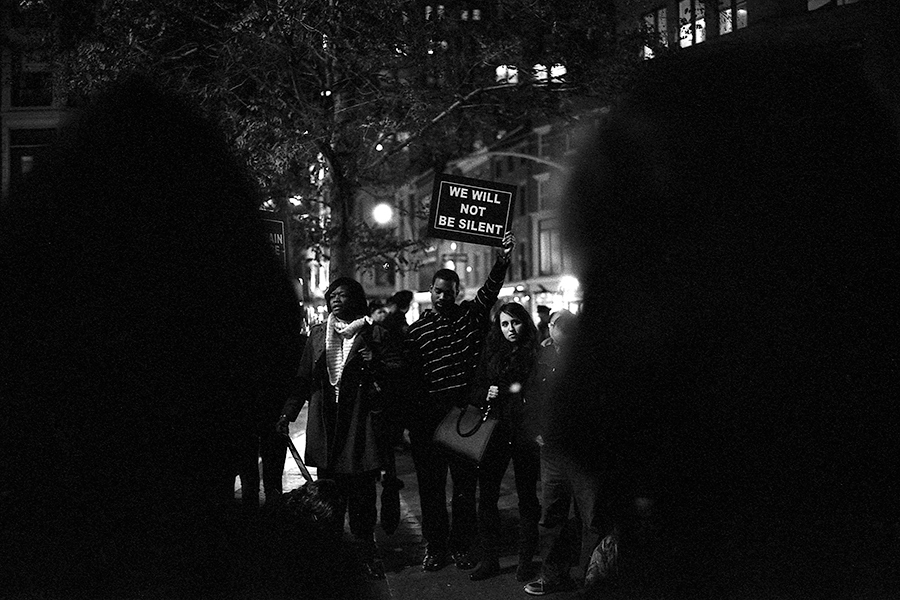 われわれは黙っていない(2014年11月25日、ニューヨーク市、ユニオンスクエア)©Robert E. Gerhardt, Jr.
われわれは黙っていない(2014年11月25日、ニューヨーク市、ユニオンスクエア)©Robert E. Gerhardt, Jr.
はじめに「マイク・チェック」と名付けた理由
私はプロの写真家として21年間撮影を続けてきましたが、この6年間は特に「Mic Check/マイクチェック」というテーマに絞って、ニューヨーク市での「Black Lives Matter/ブラック・ライブズ・マター」というムーブメントの記録に力を注いできました。
タイトルの「Mic Check/マイクチェック」は、集会でリーダーが何か言いたいことがある時に使う 「Mic Check/マイクチェック」という合図の言葉です。この「Mic Check/マイクチェック」という言葉が発せられると、集まった群衆が静まり返り、そこで、 リーダーがメッセージを伝えます。リーダーの言葉は、群衆が伝言ゲームのように繰り返し次第に大きな声となるという仕組みです。これは、拡声器などの人工的な道具を使わなくても、リーダーの伝えたい言葉が増幅されていき、大規模なグループにメッセージを伝える際には非常に効果的な方法です。
I have been a professional photographer for twenty-one years. For the last six of those I have been documenting the Black Lives Matter Movement in New York City for my series Mic Check. The title comes from the practice of protest leaders shouting “Mic Check” to those in the crowd to signal that they have something to say. Once the message has been given by the leader, the members of the crowd repeat it loudly like a game of telephone so that everyone can hear without the need for any kind of artificial amplification like a bullhorn. It is a very effective way to get a message out to a large group.
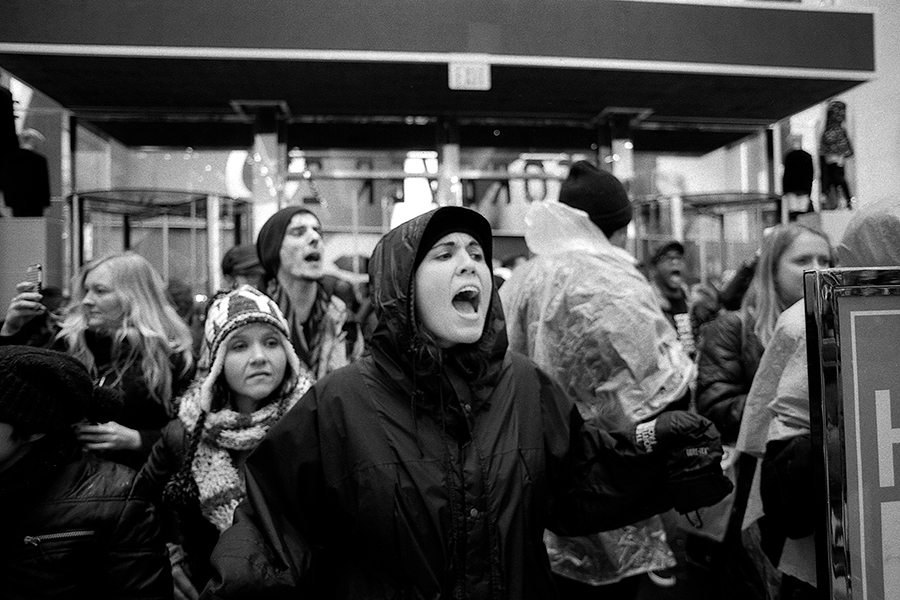 タイムズスクエアのフォーエバー21前での抗議集会(2014年12月6日、ニューヨーク市)©Robert E. Gerhardt, Jr.
タイムズスクエアのフォーエバー21前での抗議集会(2014年12月6日、ニューヨーク市)©Robert E. Gerhardt, Jr.
2014年11月、抗議集会の取材を開始
私は、マイケル・ブラウンが白人警察官ダレン・ウィルソンにより死に至ったミズーリ州ファーガソンでの事件の免罪をめぐる抗議集会がニューヨーク市で始まった2014年11月下旬から、 このプロジェクトに取り組んできました。その後まもなくスタテン島で、白人警察官ダニエル・パンタレオがエリック・ガーナーを死に至らしめた事件の大陪審でも警察官が免罪になり、警官によるアフリカ系アメリカ人の殺害に対する怒りが爆発。抗議する人たちは、Akai Gurley, Tamir Rice, Freddie Gray, Sandra Bland, Jamar Clark, Philando Castile, Terence Crutcher, Botham Jean, Stephon Clark, Eric Logan, らの名前を書いたプラカードを持って通りを占拠するなど、抗議集会が広がっていきました。
My project began in late November of 2014 when protesters gathered in New York City over the exoneration of white police officer Darren Wilson for the of death Michael Brown in Ferguson, Missouri. Shortly afterward, a second Grand Jury considering the death of Eric Garner at the hands of white police officer Daniel Pantaleo on Staten Island also led to the police officer being exonerated by the grand jury. These events opened a tidal wave of outrage over the killings of African Americans at the hands of the police. Protesters continued to take to the streets, over and over, for a long litany of names of those killed during interactions with police: Akai Gurley, Tamir Rice, Freddie Gray, Sandra Bland, Jamar Clark, Philando Castile, Terence Crutcher, Botham Jean, Stephon Clark, and Eric Logan, among many others.
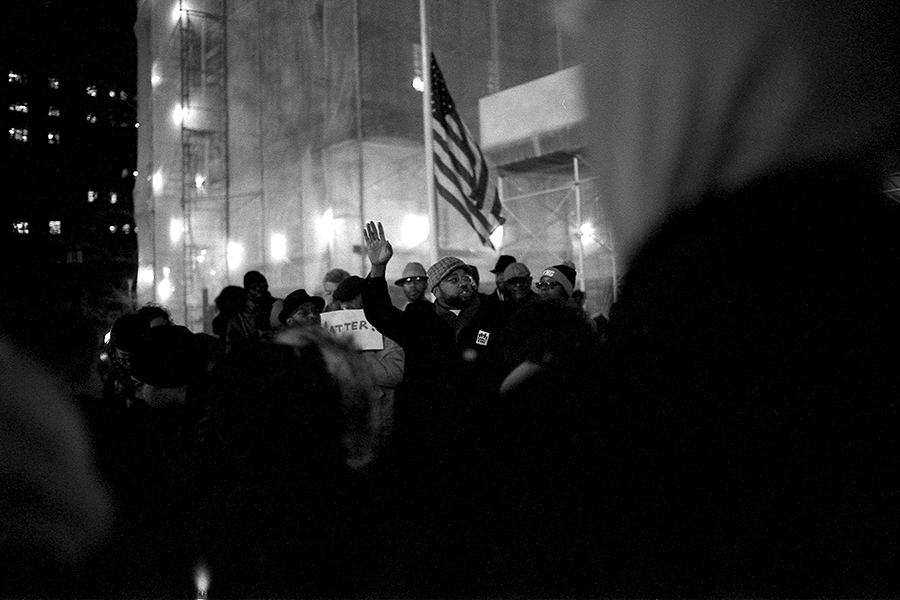 ニューヨーク市役所前での集会(2014年12月19日)©Robert E. Gerhardt, Jr.
ニューヨーク市役所前での集会(2014年12月19日)©Robert E. Gerhardt, Jr.
事件の記憶が消え去らぬよう追い続ける
時には何千人もの人々が参加する抗議活動もありましたが、少人数の抗議活動も数多く行われていました。目的は、これらの事件を忘れないために、そしてまた、 事件が解決されないままであることを覚えていてもらうためでした。彼らは諦めずに抗議を続け、そして彼らの行動を私も追い続けました。
Even when the crowds thinned out between the largest of the protests which sometimes involved thousands of people, there was a group of dedicated organizers who continued to take the streets with smaller groups of protesters to continue. Their goal was to not let the message of the movement be forgotten, and to make sure those who saw them know that they were still there and fighting for justice. Some of these protests were just a few dozen people, but they kept going. And where they went, I went, too.
2015年
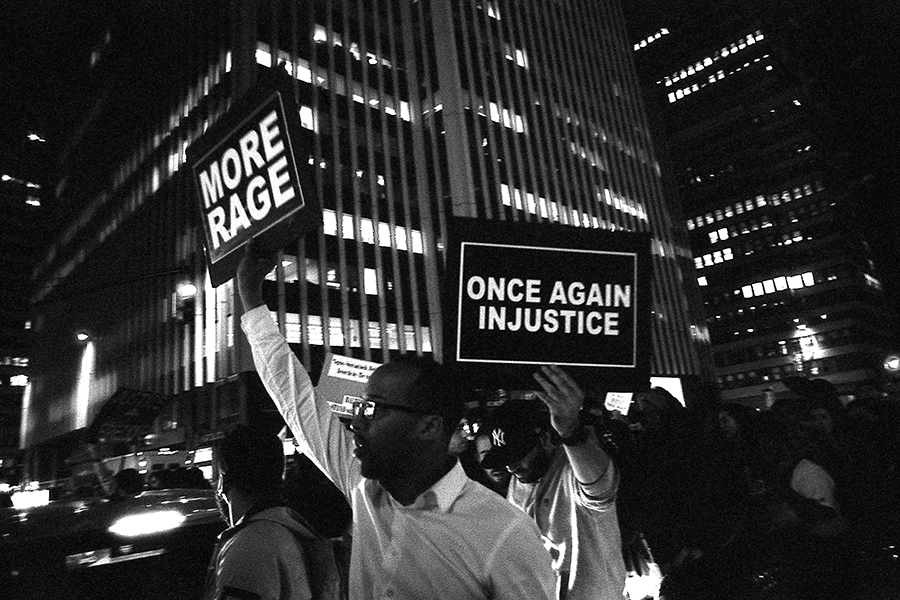 タイムズスクエアで行われた集会には「激怒」というプラカードが(2015年4月29日)©Robert E. Gerhardt, Jr.
タイムズスクエアで行われた集会には「激怒」というプラカードが(2015年4月29日)©Robert E. Gerhardt, Jr.
警察とアフリカ系アメリカ人の間に横たわる問題を伝える
私が「Mic Check/マイクチェック」というシリーズで撮影を始めた時期は、すでに、マイケル・ブラウンとエリック・ガーナーの事件は多くの人が知るところでした。大陪審の決定の日が近づくにつれ、私は、もしも警察官の無罪が認められたとしたら、ニューヨーク市民の怒りは沸騰するということへの確信がありました。髪がブロンドで青い目、しかも白人の男性という私の風貌から、マイケル・ブラウンやエリック・ガーナー、そして多くのアフリカ系アメリカ人が直面したような出来事を体験するという恐怖はありません。警察との言い合いが原因で殺害される心配もありませんし、警察を恐れる理由はありません。しかし、私はカメラという道具を持っています。この道具を使えば、警察とアフリカ系アメリカ人の間に横たわる問題を撮影して伝えることができます。
When I began photographing, I had been following the original stories of Michael Brown and Eric Garner in the news. As the anger over their deaths grew and the decisions of the grand juries drew closer, I knew that the outrage would boil over into the streets of New York City if the police involved were not found guilty. As a blond haired, blue eyed, white male I also knew that what had happened to Michael Brown, Eric Garner and so many other African Americans would never happen to me because of how I look. I have never feared the police, or worried that an interaction with police would lead to my death. Those scenarios had never crossed my mind. But I knew that I had my cameras, and I could use them as a tool to try and create a story about the issues between the police and African Americans through the photographs I could make.
2016年
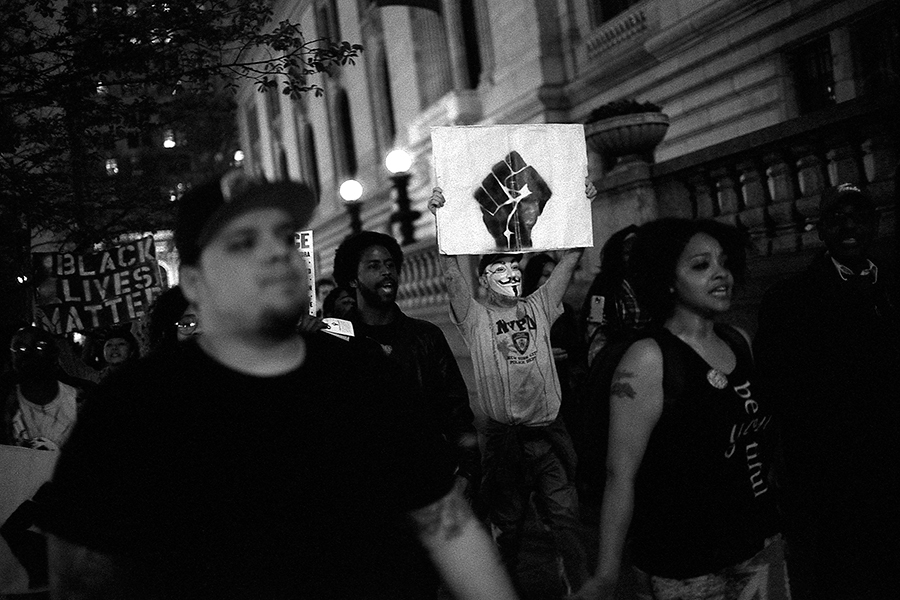 42通りに面したニューヨーク公共図書館を通過するデモ隊。「Black Lives Matter」の文字が見える
42通りに面したニューヨーク公共図書館を通過するデモ隊。「Black Lives Matter」の文字が見える
(2016年4月18日)©Robert E. Gerhardt, Jr.
アートとジャーナリズムを融合するモノクロフィルム取材
今までの仕事を自分自身で振り返ってみると、ジャーナリズム、ドキュメンタリー、アートが交差する部分にフォーカスして、長期にわたっての取材が多かったようです。撮影した写真の多くは、カレッジや大学のアートギャラリーの壁に展示され、学生が、写真について、または写真を通して社会におきている出来事を学ぶ為の展示として紹介されてきました。大学では、芸術の学位を取得していますが、ジャーナリズムの根本理論やフォトジャーナリストとしての倫理感も大事にしてきました。そんな私にとって、 白黒のフィルムで撮影した写真は、暗室での仕事も含めて愛着がある作業です。
My work has always been long-term looks into stories that lay on the edge of journalism, documentary and art. While my photographs have been published, it is almost more likely to see them on the walls of college and university art galleries where they are used to engage students about both photography and current events. I have a Master of Fine Arts degree, but strictly adhere to journalistic standards and a photojournalist’s code of ethics. The fact that I still photograph exclusively with black and white film and do my own darkroom printing just further adds to the muddy waters of where my work fits in.
戦後のグラフジャーナリズムに触発され
私が最も影響を受けたのは、1950年代と1960年代に大判の写真雑誌に作品を発表していた写真家たちの作品です。
グラフ雑誌「LIFE」からは、写真家が写真に込めた物語と、写真の美しさが伝わってきました。 1967年、ニューヨークのハーレムに住む貧しい家族を記録したゴードン・パークスの作品「A Harlem Family/ハーレムファミリー」、 1965年、ベトナム戦争のヘリコプター乗組員の 1日を記録した「One Ride with Yankee Papa 13 /ヤンキーパパとのラリーバロウズのワンライド13」、1948年、ユージーン・スミスが、田舎で生きる医者を取材した 「Country Doctor/カントリードクター」。
私がフィルムで撮影をするのが好きなのはこれらの作品に出会ったことが理由の1つで、銀塩のフィルムで撮影された写真に勝るものはありません。引き伸ばし機でイメージを紙に焼き付け、現像液が入ったトレイから映像が見えてくるのは、まさに魔法です。そして、さらに言うなら、自分で決めたテーマで取材するというのは、出来上がった写真を急いで編集者に送るという締め切りもなく、じっくり取り組めるという魅力もあります。
My biggest influences have been the photographers who come from the 1950’s and 1960’and their photo essays for the large format photo magazines. The photo series not only told stories, but the individual photographs were beautiful in their own right. You can see all over LIFE magazine: in Gordon Parks’ work documenting a poor family living in Harlem in New York City in 1967 for A Harlem Family; in Larry Burrows’ One Ride with Yankee Papa 13 which documents a day in the life of a Vietnam War helicopter crew in 1965; and W. Eugene Smith’s exploring the life of rural doctor in Country Doctor from 1948. And that is one of the reasons I love working with film so much. To my eye, there is nothing like a silver gelatin print. It is still magic to me when you expose the paper in the enlarger, then watch as the photograph appears as if out of nowhere as you agitate it in the tray of developer. And because I don’t have deadlines that require the instant transmission of my work to a photo editor, the extra time involved is not an issue.
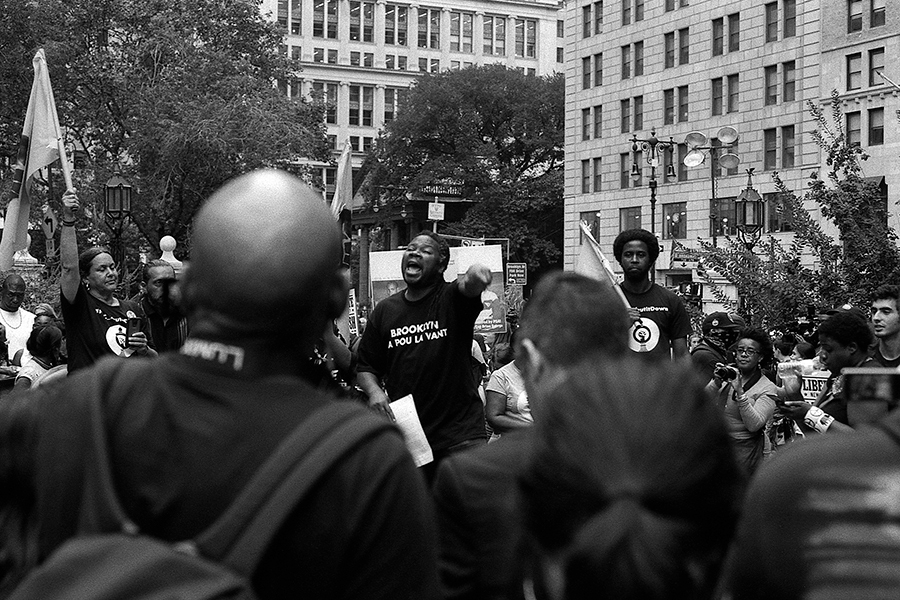 ニューヨーク市庁舎公園前で怒りの声をあげる市民(2016年8月1日、ニューヨーク市)©Robert E. Gerhardt, Jr.
ニューヨーク市庁舎公園前で怒りの声をあげる市民(2016年8月1日、ニューヨーク市)©Robert E. Gerhardt, Jr.
自分の思いを人に押し付けず、ただ事実を提供する
自分の作品が、その作品を見た人の心を変えるような 可能性はかなり低いことも、写真家として理解しています。強烈な影響力を持つ写真家は歴史的にも稀です。写真は、自分自身の世界の見方や、自分が見ている状況と深く関係していると痛感します。私は、私の写真を見る人々の心に何か期待したり、自分がファインダーから覗いた時に捉えたかった思いを、写真を見た人に押し付けたりしないようにしています。むしろ、私の写真を見て考え、その問題について話す機会が生まれるのを望んでいます。私にとって、それがジャーナリズムの正しい姿と考えるのです。何を考えるべきかを伝えるのではなくそれぞれ自分なりに考えるための事実や情報を提供します。
I also know that as a photographer, the chances of my photographs changing a viewer’s mind just by seeing my work is rather slim. Very few photographs in the history of the medium are powerful enough to do that. I am also acutely aware that my photographs are an expression of how I empathize with the world and how I relate to what I see. But I am not trying to create an epiphany in the minds of those who see my photographs or try and force them to think and feel the way I do about what I capture in my viewfinder. Rather I am trying to create a way for people to think and talk about the subjects that I cover. And to me that is what good journalism is: not telling people what to think, but rather giving them the facts and information they need to think on their own.
2017年
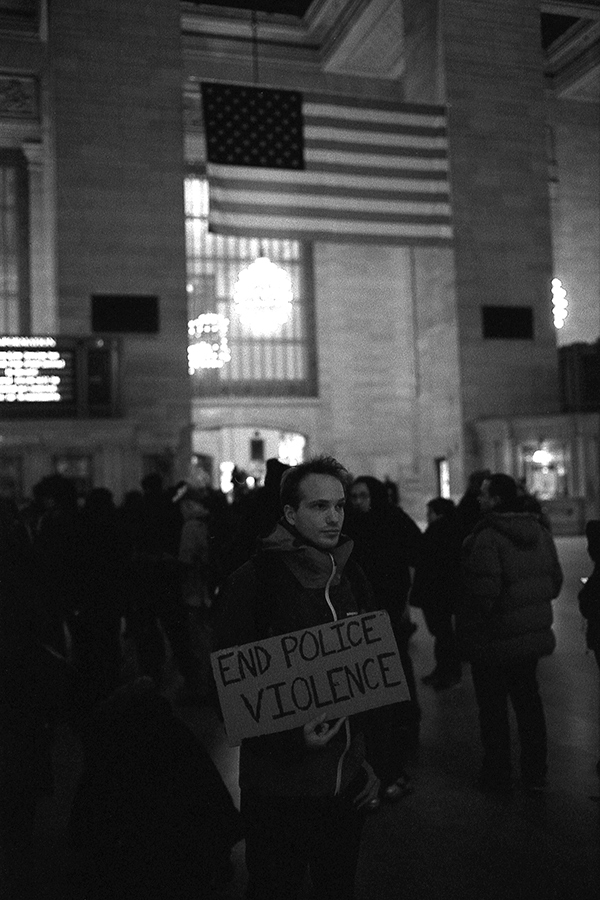 グランドセントラルターミナルで「警官の暴力に終止符を」のプラカードを掲げる人
グランドセントラルターミナルで「警官の暴力に終止符を」のプラカードを掲げる人
(2017年2月13日) ©Robert E. Gerhardt, Jr.
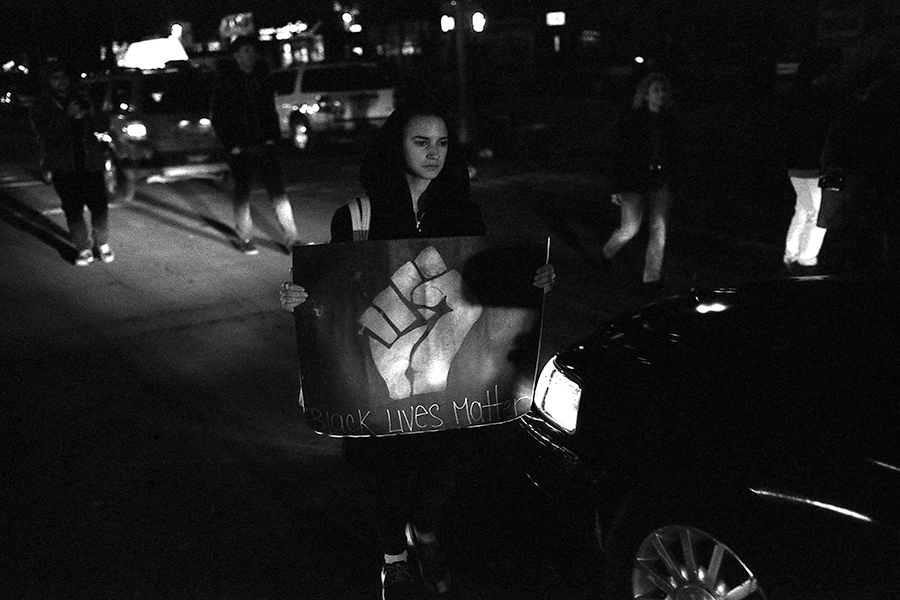 「Black Lives Matter(黒人にも生きる権利が!)」、ハーレムのMalcolm X 通りにて
「Black Lives Matter(黒人にも生きる権利が!)」、ハーレムのMalcolm X 通りにて
(2017年3月20日、ニューヨーク 市) ©Robert E. Gerhardt, Jr.
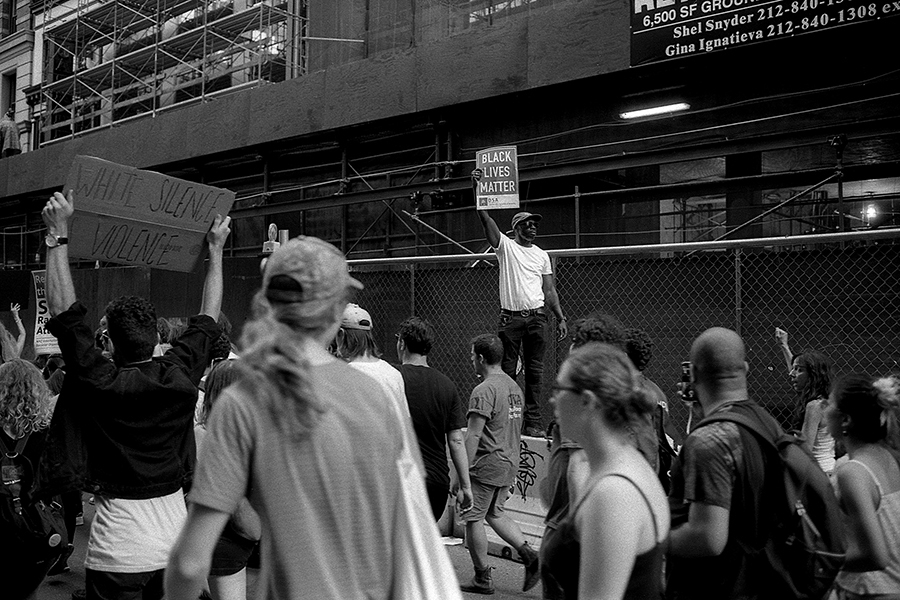 「マンハッタンの中心街で「Black Lives Matter(黒人にも生きる権利を)」と呼びかける人
「マンハッタンの中心街で「Black Lives Matter(黒人にも生きる権利を)」と呼びかける人
(2017年8月1日、ニューヨーク市)©Robert E. Gerhardt,Jr.
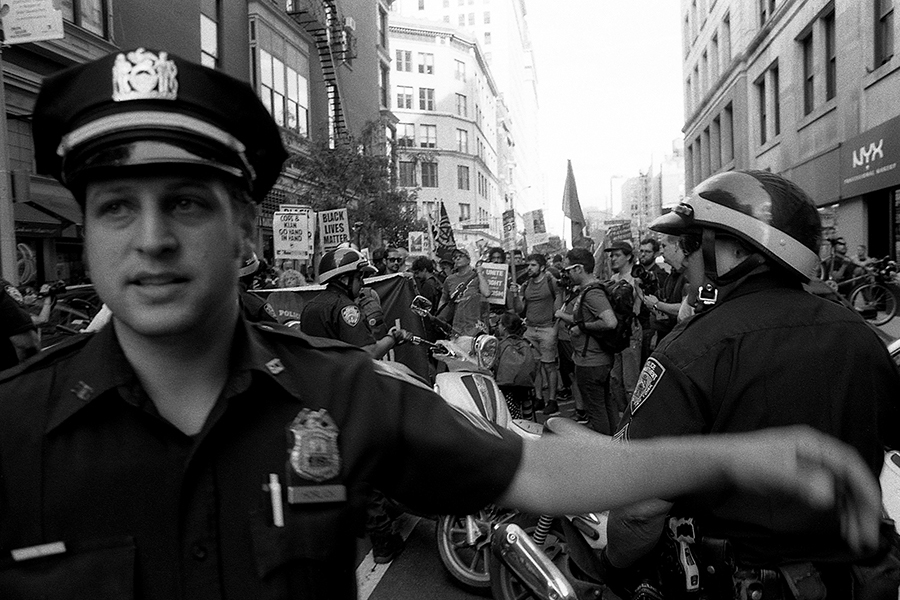 抗議者がユニオンスクエア公園内を離れないように阻止する警官(2017年8月13日) ©Robert E. Gerhardt, Jr.
抗議者がユニオンスクエア公園内を離れないように阻止する警官(2017年8月13日) ©Robert E. Gerhardt, Jr.
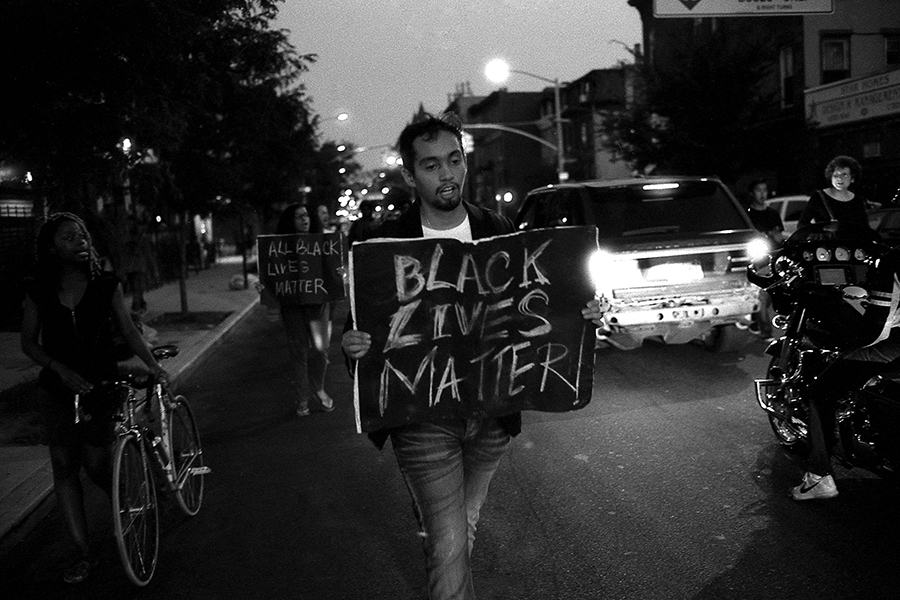 ベッドフォード・スタイベサントで行進するデモ隊(2017年8月21日、ブルックリン区) ©Robert E. Gerhardt, Jr.
ベッドフォード・スタイベサントで行進するデモ隊(2017年8月21日、ブルックリン区) ©Robert E. Gerhardt, Jr.
2018年
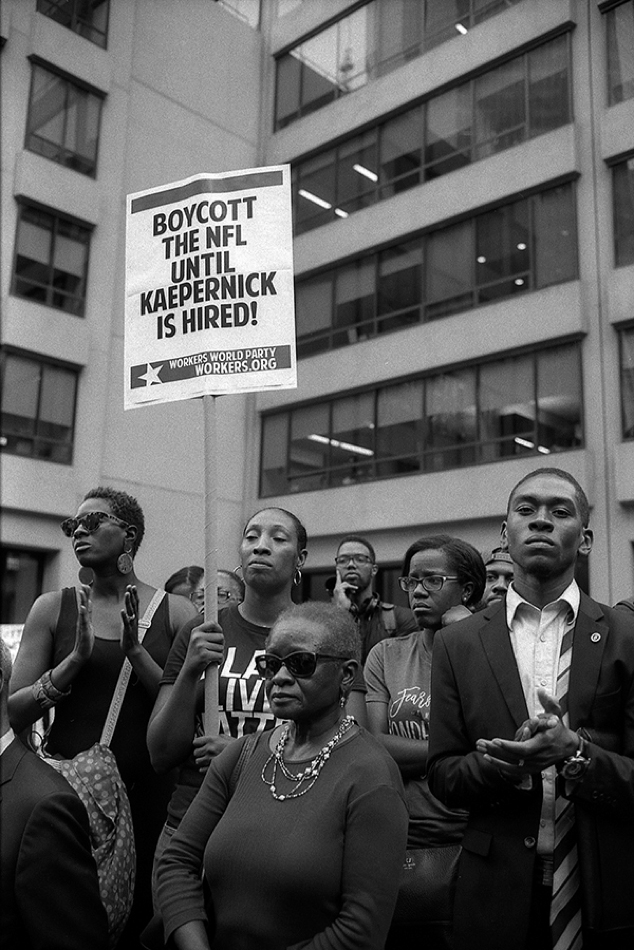 米ナショナル・フットボール・リーグ(NFL)本部前でColin Kaepernickを支持する抗議集会
米ナショナル・フットボール・リーグ(NFL)本部前でColin Kaepernickを支持する抗議集会
(2017年8月23日、ニューヨーク市) ©Robert E. Gerhardt, Jr.
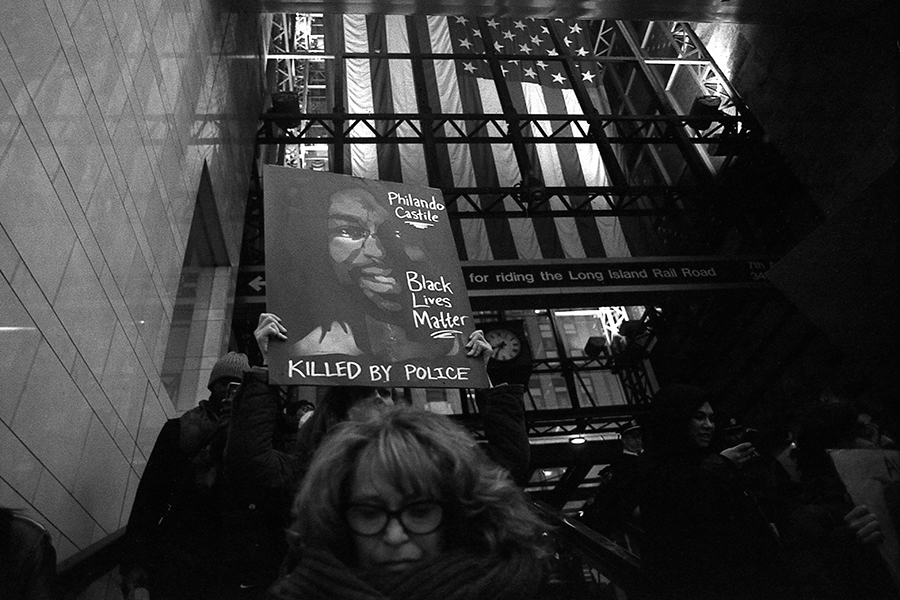 警官に殺されたフィランド・カスティーリャの追悼集会
警官に殺されたフィランド・カスティーリャの追悼集会
(2018年2月12日、ペンステーション、ニューヨーク市) ©Robert E. Gerhardt, Jr.
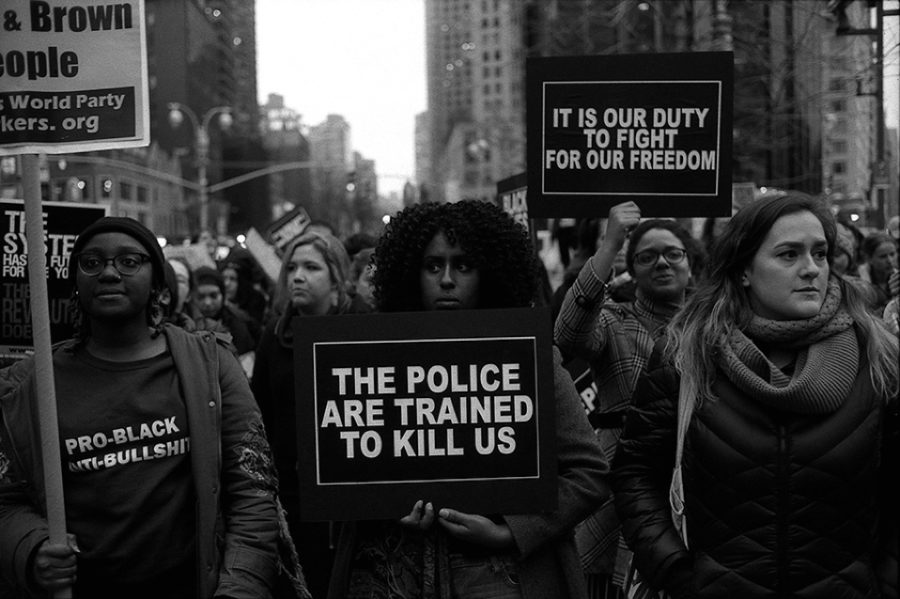 「警察は私たちを殺すよう訓練をされている」とプラカードを持っての抗議行進、
「警察は私たちを殺すよう訓練をされている」とプラカードを持っての抗議行進、
(2018年3月28日、コロンバスサークル、マンハッタン) ©Robert E. Gerhardt, Jr.
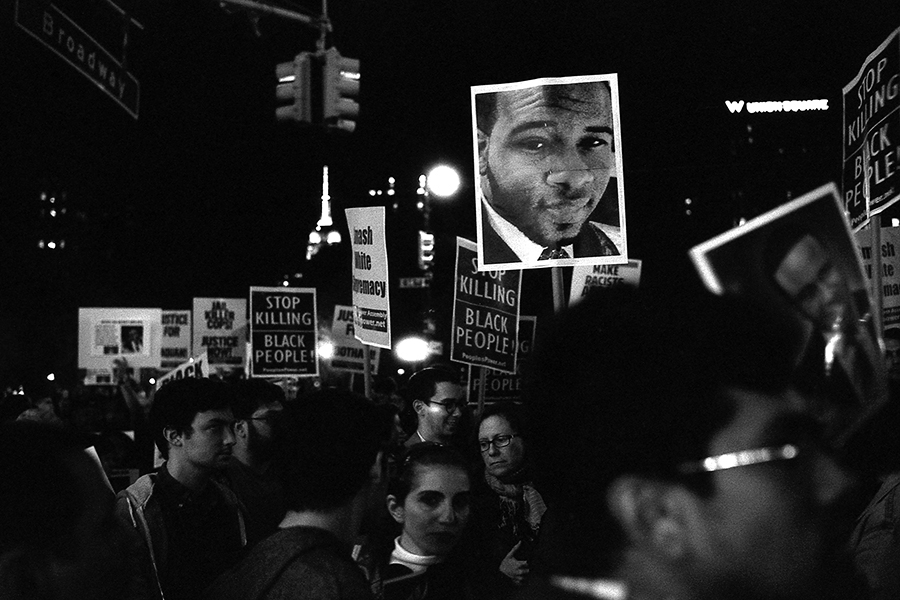 ブロードウェイでボサム・ジーンのために抗議するデモ隊
ブロードウェイでボサム・ジーンのために抗議するデモ隊
(2018年9月28日、マンハッタン、ニューヨーク市) ©Robert E. Gerhardt, Jr.
2019年
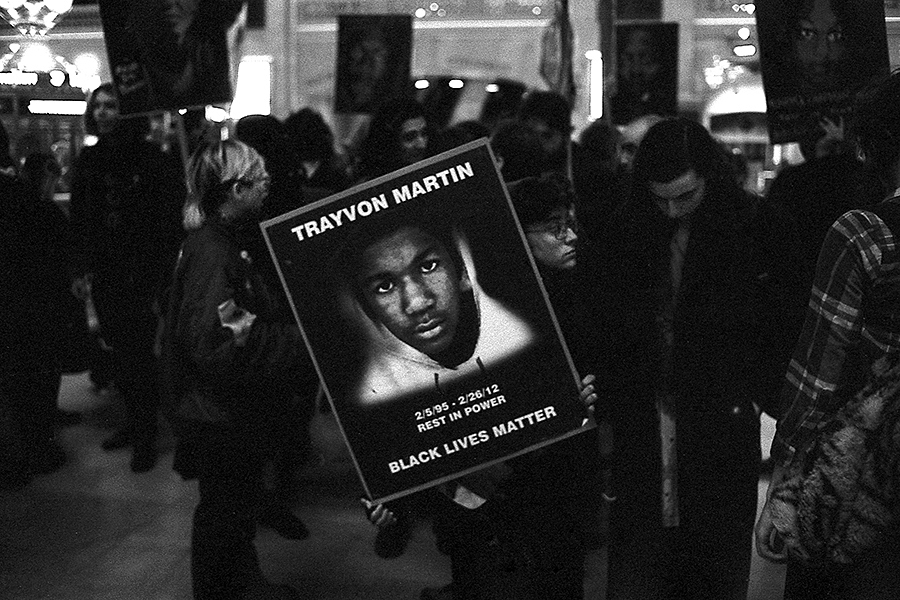 トレイボン・マーティンの死を悼み「Rest in Power(死を持って生きる)」とプラカードを掲げる人
トレイボン・マーティンの死を悼み「Rest in Power(死を持って生きる)」とプラカードを掲げる人
(2019年2月4日、グランドセントラルステーション、ニューヨーク市) ©Robert E. Gerhardt, Jr.
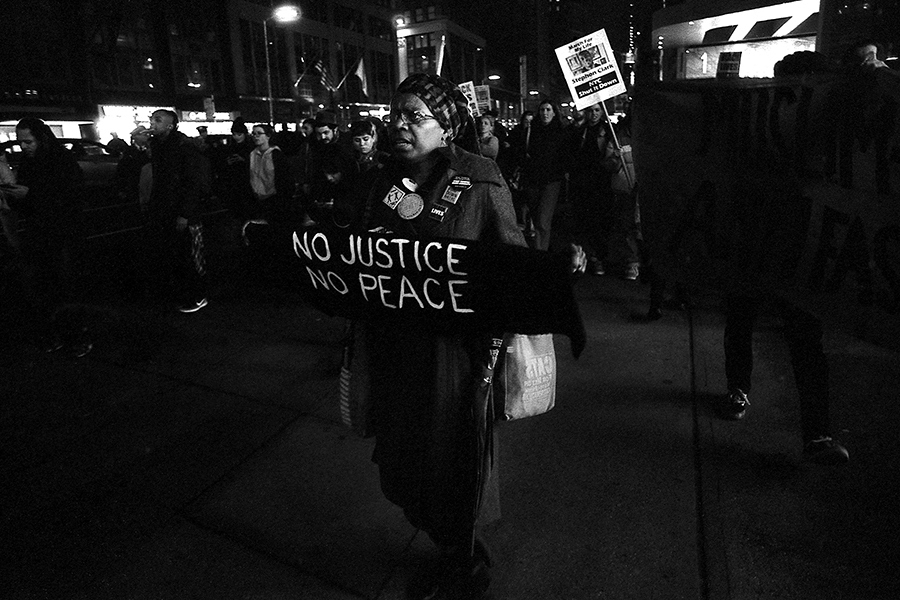 「No Justice No Peace / 正義なくして、平和なし」
「No Justice No Peace / 正義なくして、平和なし」
(2019年3月10日、ミッドタウンマンハッタン、ニューヨーク市) ©Robert E. Gerhardt, Jr.
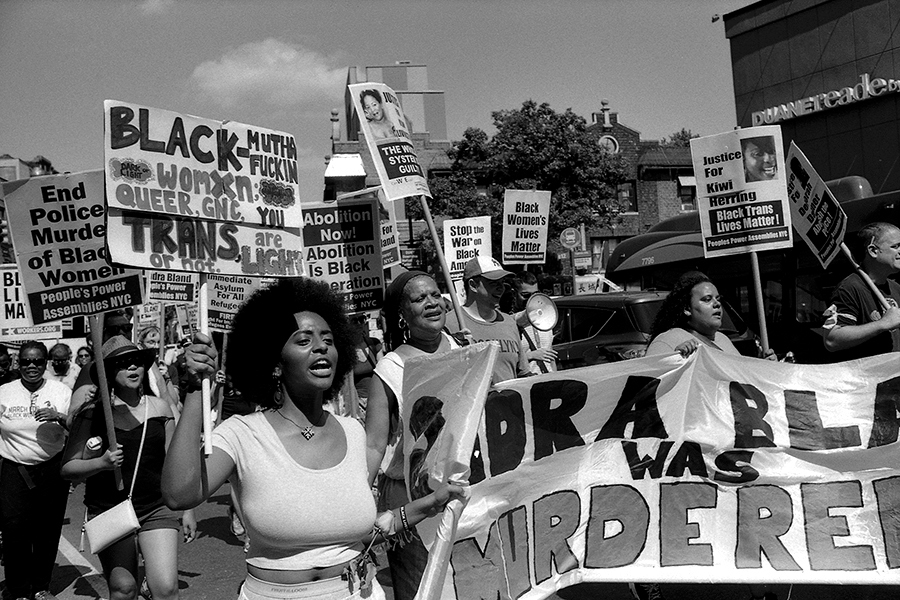 サンドラ・ブランドの死から4年後に集まった抗議者たち(2019年7月13日、ブルックリン、ニューヨーク市) ©Robert E. Gerhardt, Jr.
サンドラ・ブランドの死から4年後に集まった抗議者たち(2019年7月13日、ブルックリン、ニューヨーク市) ©Robert E. Gerhardt, Jr.
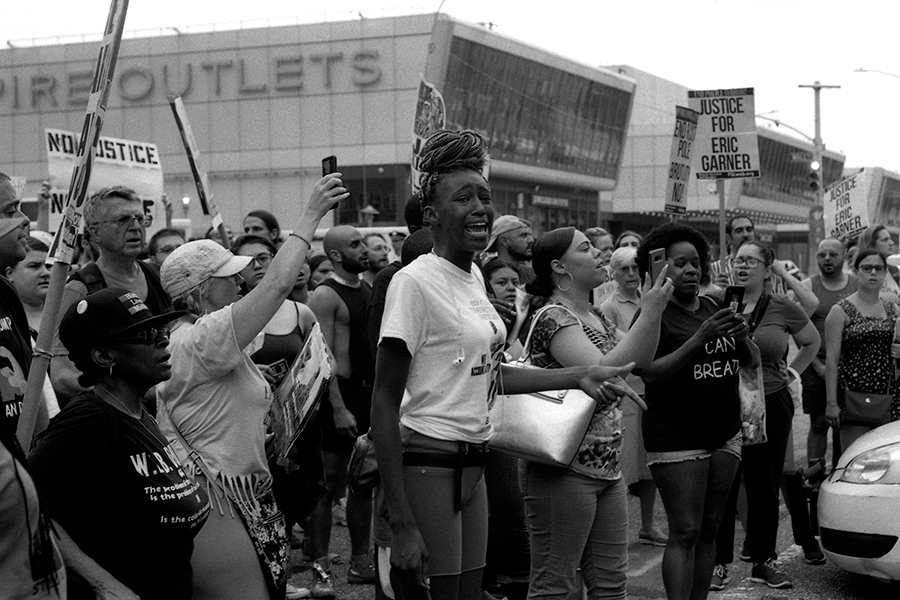 エリック・ガーナーの死後5周年、120区にある警察所前で叫びをあげる家族
エリック・ガーナーの死後5周年、120区にある警察所前で叫びをあげる家族
(2019年7月17日、スタテン島、 ニューヨーク市) ©Robert E. Gerhardt, Jr.
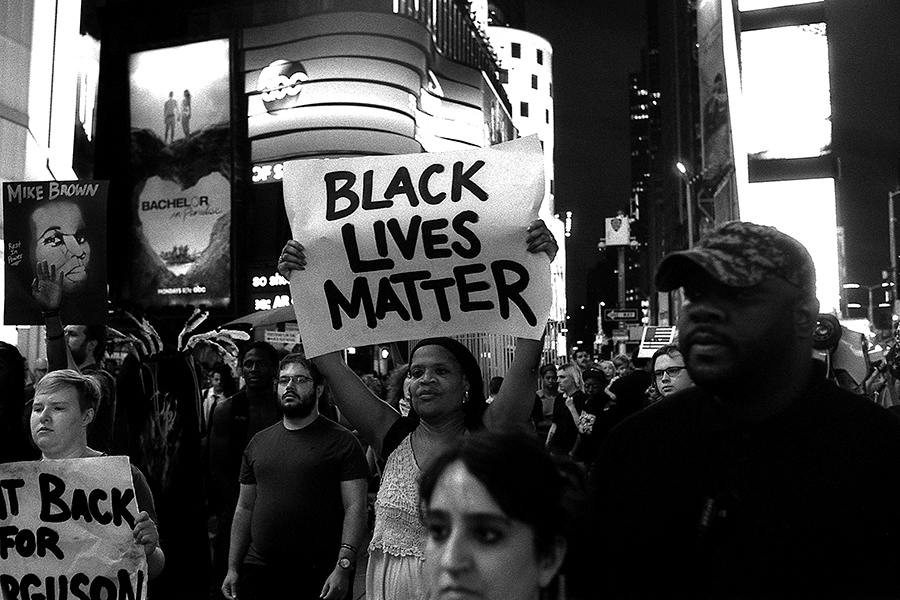 マイケル・ブラウンの死後5周年、タイムズ・スクエアに集まった人たちの抗議集会
マイケル・ブラウンの死後5周年、タイムズ・スクエアに集まった人たちの抗議集会
(2019年8月9日、マンハッタン、ニューヨーク市) ©Robert E. Gerhardt, Jr.
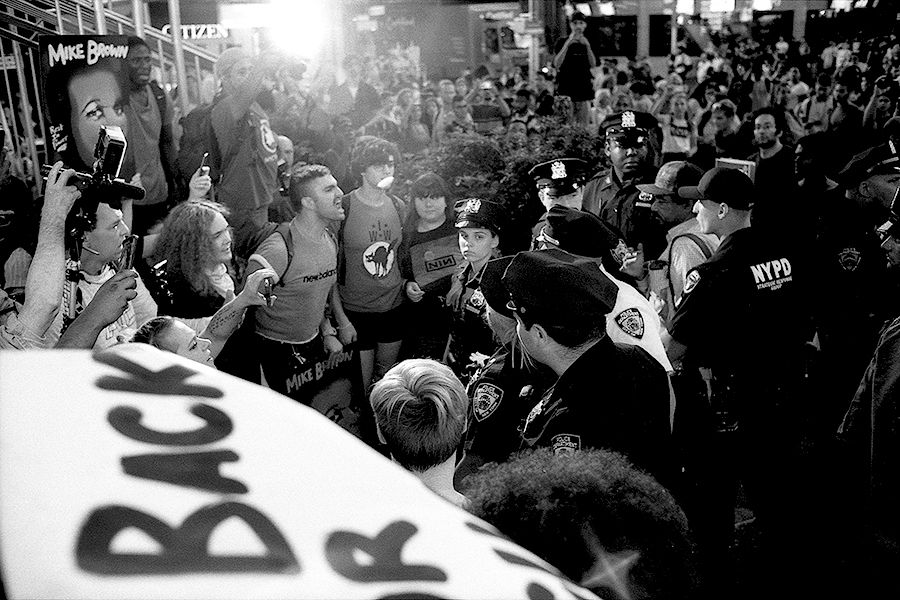 マイケル・ブラウンの死から5年、タイムズ・スクエアで警察官に立ち向かって怒りの声をあげる抗議者
マイケル・ブラウンの死から5年、タイムズ・スクエアで警察官に立ち向かって怒りの声をあげる抗議者
(2019年8月9日、マンハッタン、 ニューヨーク市) ©Robert E. Gerhardt, Jr.
2020年
コロナ禍のなか、ジョージ・フロイドさんの死をきっかけに再び街に
ミネソタ州ミネアポリスで起こった4人の警官によるジョージ・フロイドさんの死をきっかけに、各地でさらなる抗議活動が広がっています。私もその記録をするために街頭に出ていきます。カメラバッグには常に、2つまたは3つのカメラ本体、さまざまな焦点距離のレンズ 、そして持ち運べるだけのフィルムが入っています。 以前と違うのは、世界中で 依然として蔓延しているCovid-19の拡大を防ぐために、マスクをカバンに入れ、撮影する人々との社会的距離を空ける努力です。
Now the protestors have returned again over the death of George Floyd at the hands of four police officers in Minneapolis. Minnesota. And with the return of the protests, I too have returned to the streets to document the movement. My camera bag has always been packed and ready to go: 2 or 3 camera bodies, a selection of lenses of various focal lengths, and as much film as I can carry. But in a world where Covid-19 is still running rampant, my kit now also includes masks to help prevent the spread of the disease, and I now practice social distancing with those who I am photographing.
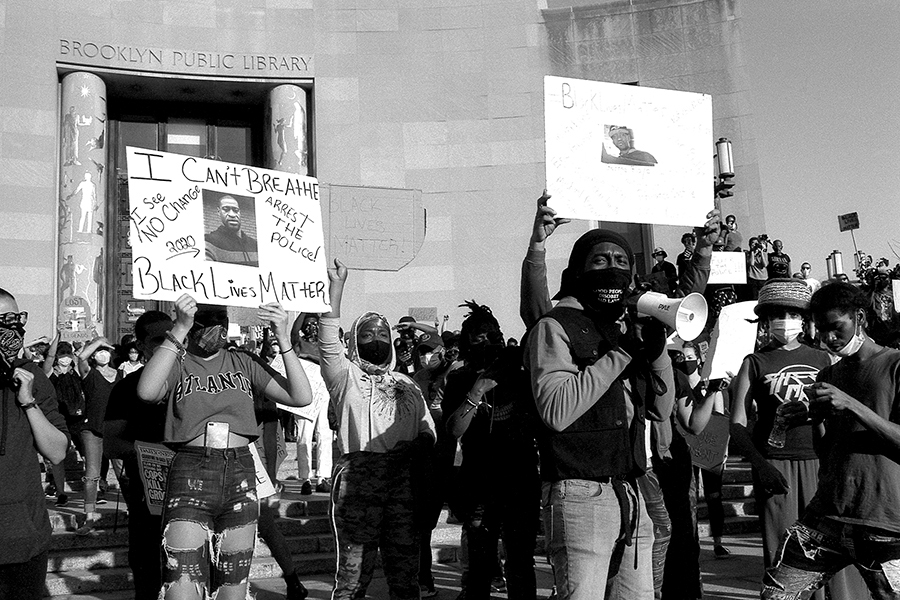 ブルックリンのグランド・アーミー・プラザ内にある公共図書館の階段で群衆に話す抗議リーダー
ブルックリンのグランド・アーミー・プラザ内にある公共図書館の階段で群衆に話す抗議リーダー
(2020年5月30日、ニューヨーク市 ) ©Robert E. Gerhardt, Jr.
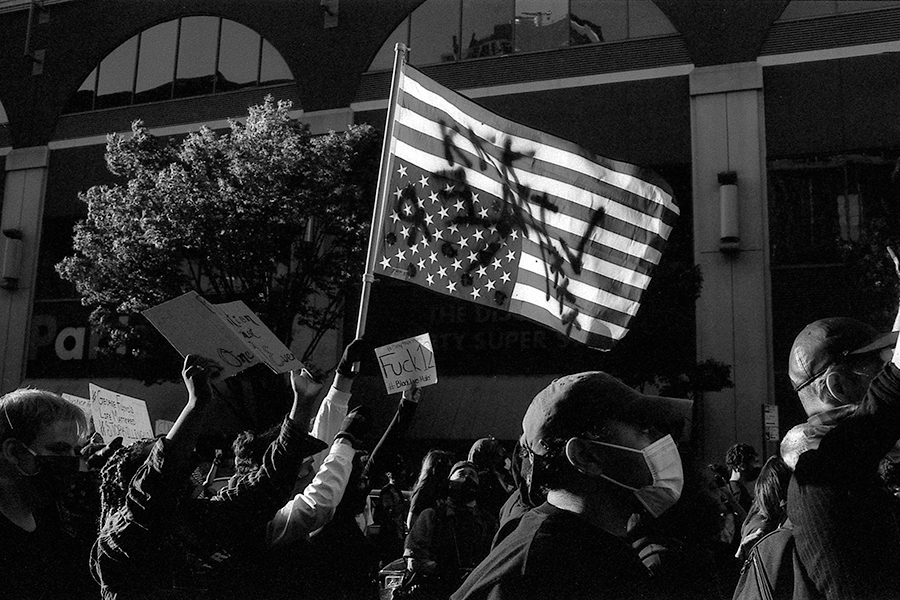 ブルックリンにあるバークレイズ・センター近くのアトランティック通りで、アメリカの旗を逆さまに振って抗議する人たち
ブルックリンにあるバークレイズ・センター近くのアトランティック通りで、アメリカの旗を逆さまに振って抗議する人たち
(2020年5月31日、ニューヨーク市) ©Robert E. Gerhardt, Jr.
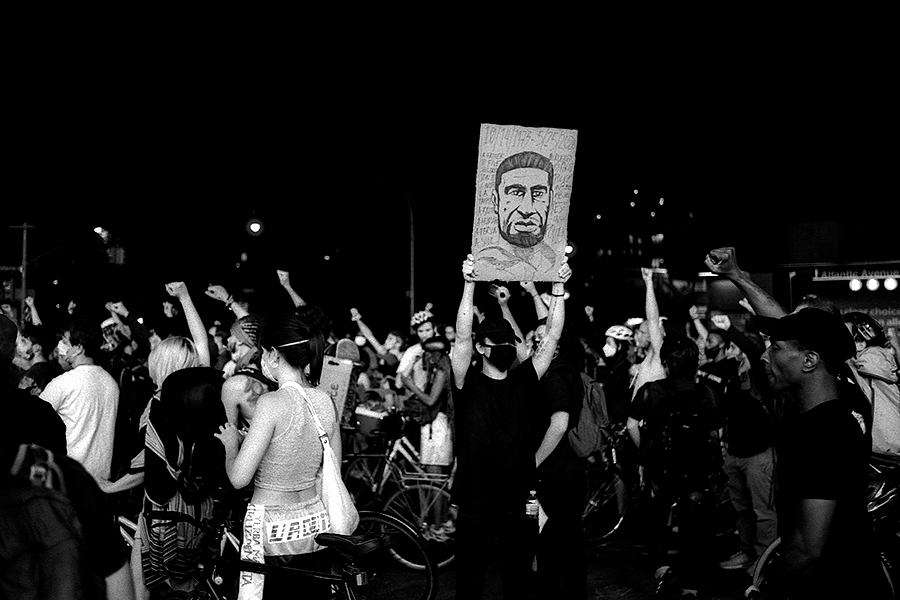 ブルックリンのバークレイズ・センターで、ジョージ・フロイドの手描きの肖像画を掲げる抗議者
ブルックリンのバークレイズ・センターで、ジョージ・フロイドの手描きの肖像画を掲げる抗議者
(2020年6月6日、ニューヨーク市) ©Robert E. Gerhardt, Jr.
以前とは違う抗議者の様相
今回の抗議デモを撮影していて、抗議者たちが以前とは異なるということを感じています。それは、今までと比べて規模が大きいだけでなく、抗議行動の継続性 と、数の多さです。これまでに経験したことがない強烈な印象を受けています。
数々の抗議デモの後でも、大量のアフリカ系アメリカ人を逮捕し殺害している点では、以前としてあまり変わっていません。警察は、ボディカメラの着装を義務づけるなど、いくつかの改良をしましたが、影響はまだあまり確認できていません。全国で発生する警察の暴力事件を、マスコミが取材してニュースで取り上げられることで、問題改善の速度は今までよりも早まっていますが、いまだ少数の警察官への影響があっただけというのが現状です。しかし、ゆっくりと変化しています。
What I have been acutely aware of as I am out photographing is that this time the protests feel different then they have in past. Not only are the crowds bigger than I ever remember seeing, but their longevity and sheer number of individual protests is greater than anything I’ve experienced before.
After previous waves of protests there were very few concrete results. Police officers are still arresting and killing African Americans at an alarming rate. Police departments have made some changes to their training regimes and added body cameras, but the effects of these changes on policing appear minimal at best. The incidents of police violence around the country do draw more scrutiny in the press and are quicker to show up on the news. But still very few police officers ever face real consequences for their actions, or any jail time, though that is slowly changing as well.
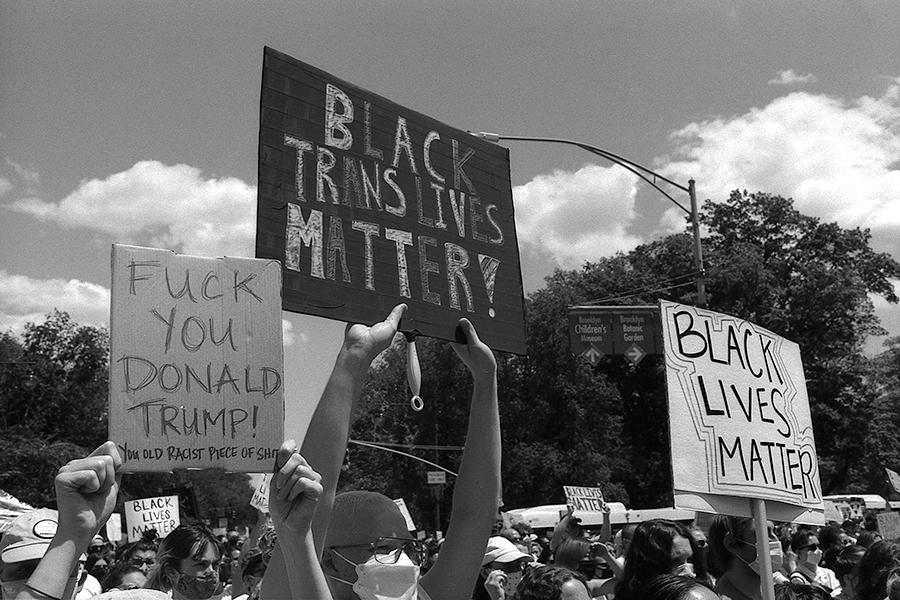 ブルックリン美術館前で行われた「Black Trans Lives Matter(黒人、トランスジェンダーの命と権利)」を支持する抗議集会には、約15,000人が集まった(2020年6月14日、ニューヨーク市) ©Robert E. Gerhardt, Jr.
ブルックリン美術館前で行われた「Black Trans Lives Matter(黒人、トランスジェンダーの命と権利)」を支持する抗議集会には、約15,000人が集まった(2020年6月14日、ニューヨーク市) ©Robert E. Gerhardt, Jr.
警察側にも変化が見えた
抗議者の行動が変化の引き金となりはじめています。ジョージ・フロイドさんを殺害した警察官は有無をいうことなく解雇されました。ミネアポリス市やニューヨーク市を含むさまざまな都市は、警察署の予算を削ることを決定し、学校の敷地内で起こった暴力を伴わない犯罪や事件についての 取り締まりをどのように対応するかなどの協議も始まっています。ニューヨーク市はまた、警察の透明性を高めるために、以前は公開されていなかった警察の不正行為ファイルを、部門外の人々がレビューできるようにする措置を講じています。これらは小さな一歩ですが、警察の暴力とあまりにも長く続いた人種差別の歴史を正すための正しい方向への一歩です。
But now it seems like the protesters are making some real changes happen. The police officers who killed George Floyd were quickly fired without dragging the incident out. Various cities, including Minneapolis and New York, are looking to work to defund the police forces by taking money from their budgets while at the same time rethinking how and who should respond to incidents that don’t involve violent crime, such as mental health issues and re-thinking who should police school grounds. New York City has also taken steps to make the police force more transparent and allow for those outside of the department to review police misconduct files that were previously hidden from the public. These are small steps, but they are steps in the right direction to correct the history of both police violence as well as the systemic racism that has gone on too long.
公民権運動の新たな章が始まる
抗議者たちの行動が終わらない限り、私は引き続き取材を続けます。
米国にとって大きな「Black Lives Matter(黒人にも生きる権利を)」という公民権運動の新しい章が始まっています。平等という権利を獲得するための最終章ではないかもしれませんが、歴史の中で重要な部分になるでしょう。「Black Lives Matter」という物語の最終章はまだ書かれていません。しかし、最初の下書きを描くために、私は、この街で写真を撮り続けようと思います。 ストーリー全体が完結するときの参考になるために、私は、今を記録します。
So as the protestors march on, I will continue to show up to document what happens. The Black Lives Matter movement is a new chapter in the greater Civil Rights Movement in the United States. It may not be the final chapter in the struggle for equal rights, but it will be an important part in its history. The full story of the Black Lives Matter movement hasn’t yet been written. But I will keep photographing to try to get at least the first draft of this chapter of history from where I stand and what I see. For me this is about creating a record of what happens now so that in the future there will be something for those to come after to reference when the full story is written.
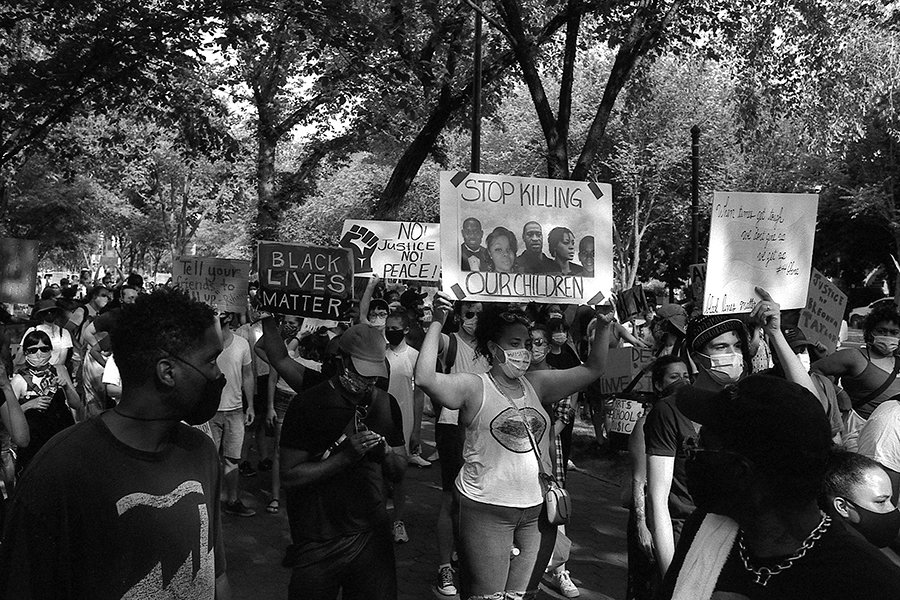 ブルックリンのイースタン・パークウェイにあるクラウンハイツ付近で行われた、「Stop Killing Our Children( 私たちの子どもを殺さないで)」抗議集会(2020年6月19日、 ニューヨーク市) ©Robert E. Gerhardt, Jr.
ブルックリンのイースタン・パークウェイにあるクラウンハイツ付近で行われた、「Stop Killing Our Children( 私たちの子どもを殺さないで)」抗議集会(2020年6月19日、 ニューヨーク市) ©Robert E. Gerhardt, Jr.
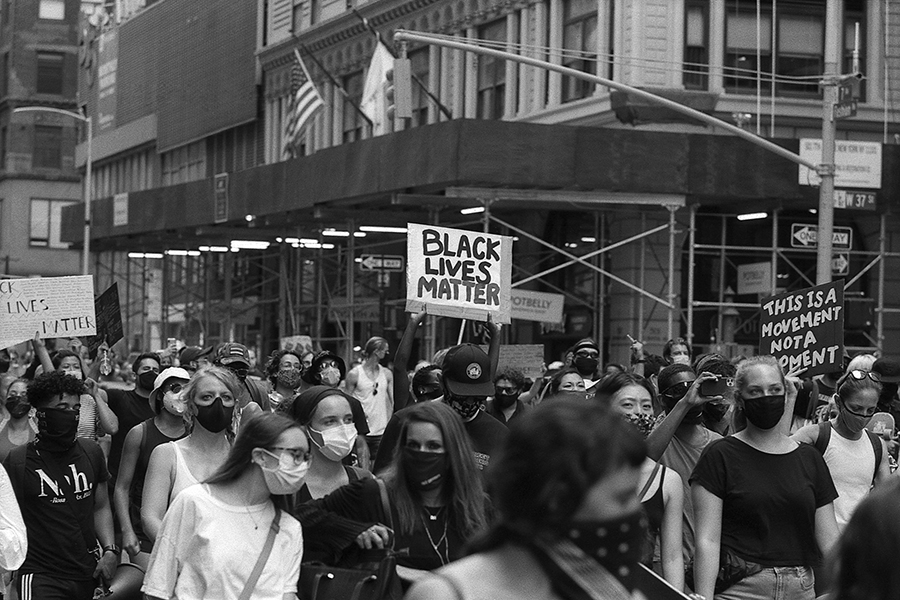 ジェイコブ・ブレークさんの死を悼み、多数の抗議者がマンハッタンをデモ行進するなか、1人が「黒人にも生きる権利を!」のプラカードをかかげる(2020年8月24日、ニューヨーク市)©Robert E. Gerhardt,Jr
ジェイコブ・ブレークさんの死を悼み、多数の抗議者がマンハッタンをデモ行進するなか、1人が「黒人にも生きる権利を!」のプラカードをかかげる(2020年8月24日、ニューヨーク市)©Robert E. Gerhardt,Jr
おわり
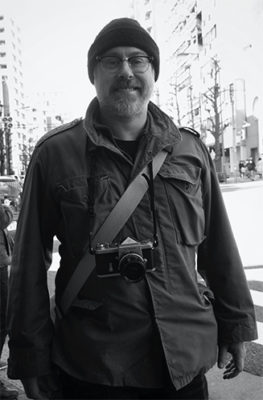 ロバート・ゲルハート氏の略歴、実績
ロバート・ゲルハート氏の略歴、実績
ニューヨークに拠点を置くフリーランスのドキュメンタリー写真家、フリーランスライター。全米報道写真協会会員及び、香港の外国特派員クラブ不在会員。
1999年、米マサチューセッツ州ウースターのホーリークロス大学卒(人類学/社会学および美術史の学士号取得)。2007年には、マサチューセッツ州ケンブリッジにあるレズリー大学・芸術・デザイン大学院で写真の修士号を取得。
作品は、北米、ヨーロッパ、アジアで数多くの個展やグループ展に出品されている。ニューヨーク市立博物館、ニューヨーク歴史協会、アラブ系アメリカ人国立美術館などに写真が所蔵されており、私的なコレクションとしても収集されている。
英高級紙「ザ・ガーディアン」、オンラインニュースマガジン「ザ・ディプロマット」、米高級紙「ニューヨーク・タイムズ」、米オンラインメディア「ハフィントンポスト」、米誌「ニューズウィーク」、イスラエル紙「ハアレツ」、「南ドイツ新聞」などのメディアなどでも写真が発表された。市民権と人権、宗教、報道の自由などをテーマとする著作もある。 香港の英字紙「フリープレス」、「ザ・ディプロマット」、オランダ紙「ザ・コレスポンデント」、米大衆紙「ブルックリンレール」には、自身の作品を紹介する記事が掲載された。
